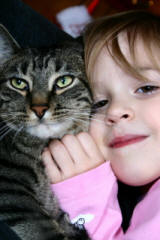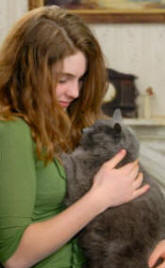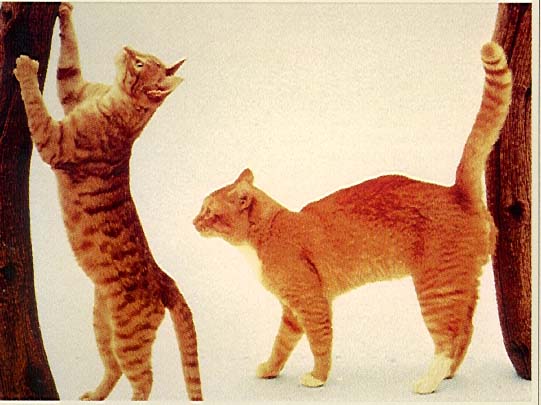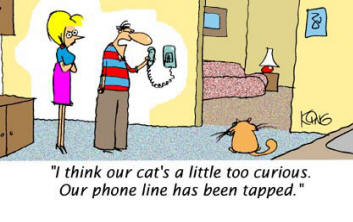|
Need Help?
|
|
Call
1-800-372-3706
to
speak to a Veterinary Behavior Technician |
|
Paws To Speak!
Member Main Menu
|
|
 |
 |
|
Help is at your
fingertips by library, email,
and phone. |
Learn more...
Body Language of Love
Normal Body Language
PowerPoint
Normal Feline Body Language

Did you Know?
Do you know how cats "find their way home"? Study in
England with "blindfolded" cats in a van theorized, Bio-magnetic particles


Most pet aggression
is fear-based

The goal:
happy relaxed relationships with no fear or
aggression.
|
Communication - How to Talk Cat!
 What is normal feline
behavior? What is normal feline
behavior?
Have
you ever wondered why your cat
wakes you up in the middle of
the night. Has your cat ever
pounced on objects that didn't
appear to exist? Does your
cat rub against your legs or the
couch? If so, you will be happy
to know that these are all
normal feline behaviors!
Feline pretend play
and prey
From the cat's point of view, it is
natural to practice night-time hunting behaviors with prey oriented play which
may result in cats chasing, even attacking moving parts of a person's body. Cats
are nocturnal and hunt at night.
Sudden changes in mood and behavior is business as
usual for cats. In nature, cats rest most of the day
interspersed with stalking and explosions of rapid
pouncing and biting prey or escaping sudden dangers.
Cat attacks are normal facets of enjoyable
play-fighting and prey-killing behaviors.
A fine line exists between pleasure from stroking
and irritation with handling, similarly between
hugging and restraint.
|
Allow cats to approach you
first. Hold a finger out for
sniffing. This is proper
greeting behavior for humans
introducing themselves. |
Cheek and
paw marking
 Cats
claim territory with marking
behaviors. Cats mark with
paws and cheeks to place
pheromones (their feline
scent) on favorite objects
and people to communicate to
other cats, "This is mine!
Scratching to sharpen a
cat's claws also helps
satisfy the cat's need for
stretching. Cats
claim territory with marking
behaviors. Cats mark with
paws and cheeks to place
pheromones (their feline
scent) on favorite objects
and people to communicate to
other cats, "This is mine!
Scratching to sharpen a
cat's claws also helps
satisfy the cat's need for
stretching.
Urine
marking
Urine
Spraying is when the cat backs up to a vertical target with the tail straight up
and quivering. Small amounts of urine sprayed up and out mark
objects.
|
The better the pet parent
can read a cat's body language,
the more capable the pet parent
will be in determining when to
back away and when to continue
social contact. |
Tails, ears, and roll-overs
Your feline's tail
has a tale to tell. When your cat's tail is held straight up, she's happy to see
you and wants to be greeted. Cats raise their tails like flags when they feel
confident and alert. As a cat's mood drops, so does the tail. Consider your
cat's tail her mood barometer. When your cat explores, read a high tail as
bravery and a low tail as uncertainty or fear. When your kitty arches her back
with a skunk-like tail, she is saying, "Please pet me, now. I'm in the mood for
love." As her tail lowers with waving or twitching, back off, she's getting
annoyed and putting up the no trespassing sign.
However, a twitching tail, ears
that flick backwards and any
other sign of muscle tension
tell you your cat is getting
annoyed and best be given
solitude.
Many
cats roll over to greet their
owners exposing their vulnerable
bellies. Some cats like
belly rubs. This position shows
trust.
|
Never
try to hold a cat against
its will. Unlike dogs, cats
don't give up and are less
likely to forgive and
forget. |
What to do
Communication between the
species (cat and humans)
enriches the cat's spirit and
creates a wonderful
relationship. Positive cat
parents teach cats how to
express natural behaviors within
acceptable house rules.
-
Learn
how to read your cat's body language.
-
Stroke your cats
cheeks from front to back to show friendship
-
Encourage cheek
marking to prevent urine marking
-
If you have
multiple cats, increase favorite objects to reduce marking

|
"Helping you raise a fabulous feline
friend for life." |
|